Mass loaded vinyl is a great go-to soundproofing product. However, it can be pretty pricey if you need a lot or, in fact, if you don’t need very much. In short, it’s expensive.
So, if you’re on a budget for your soundproofing project, here are some of the best mass loaded vinyl alternatives. Before we jump into that, it’s worth understanding what mass loaded vinyl does so we can decide which products are best.
Understanding Mass Loaded Vinyl
Mass loaded vinyl (MLV) is a flexible material (unsurprisingly) made from vinyl. It’s like a thick fabric that you attach to surfaces for extra soundproofing properties. The most important component is either barium sulfate or calcium carbonate, which gives mass loaded vinyl extra weight for its size.
MLV is a viscoelastic material. It means that, when force is applied, the product moves with the force but then returns to its original shape. A good everyday example is memory foam.
Another way of explaining this is with the term “limp mass”. MLV is limp mass because it doesn’t vibrate when force is applied to it.
How Does MLV Work?
I’ve already briefly explained this above. Mass loaded vinyl is a damping material because it acts like a sound deadening barrier for sound waves. It works as follows:
- Sound waves leave their source and travel through the air.
- They reach the mass loaded vinyl, where sound transmission should take place.
- Rather than vibrating with the sound waves like a rigid material would, MLV doesn’t, causing the waves to lose energy.
- The sound waves dissipate as they lose energy, meaning they don’t transmit through the surface.
A good way of thinking about this is if you threw a ball at a bed sheet hanging on a washing line. The ball hits the sheet and drops to the floor.
However, if that bed sheet was a piece of drywall, the ball would bounce back off and some of its energy would transmit into the drywall.
Well, mass loaded vinyl is the hanging bed sheet of the soundproofing world.
For that exact same reason, it’s recommended to install MLV with some slack, rather than compressed in between 2 hard layers (drywall for example).
To learn more about how to install MLV for effective soundproofing, check out my step-by-step guide.
Mass Loaded Vinyl and Types of Sound
We can divide sound waves into 2 types: airborne and impact.
- Airborne sounds are waves that travel through the air into surfaces (such as a wall). Common examples are TVs, people talking, and music from speakers.
- Impact noises come from an object hitting a surface, such as footsteps on a floor. The footsteps create vibrations, which pass through the floor and come out the other side as sound waves.
We use different methods to block and/or absorb impact and airborne noises due to their differing energy levels when passing through structures.
While mass loaded vinyl will help with both, it’s more useful for airborne sounds because most waves don’t go through, and dissipate when they come into contact with it. Impact sounds, on the other hand, require spongy materials or decoupling hard surfaces with softer ones.
To measure a material’s ability to attenuate sound passing through it, we use a rating called Sound Transmission Class (STC). The higher the number, the more sound it attenuates.
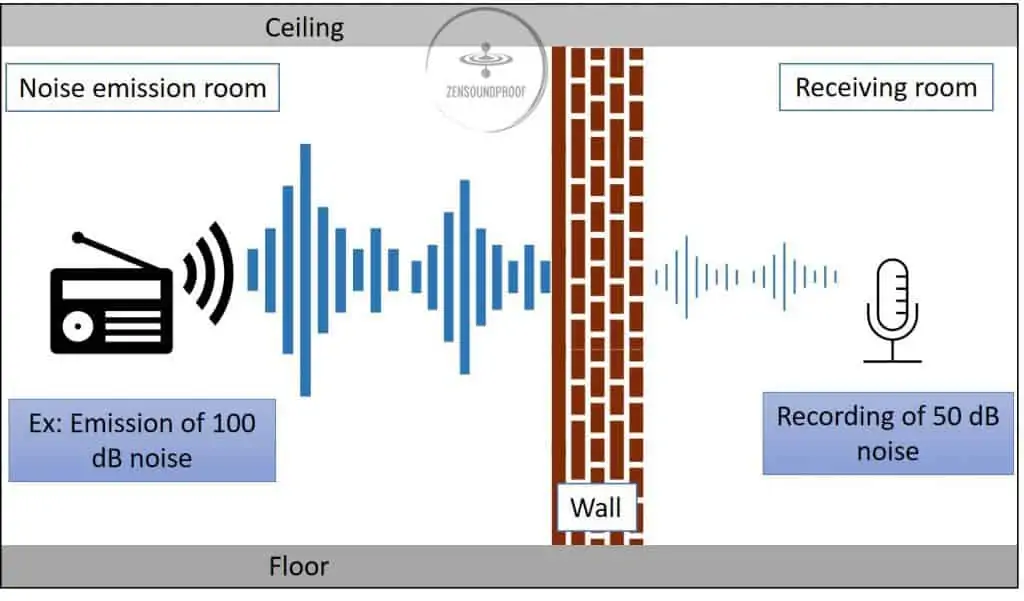
The STC of mass loaded vinyl can be anywhere from 20 to 32, which is decent for such a thin product.
So, for the best mass loaded vinyl alternatives, we must look for products with similar STC ratings.
Our 4 Recommended MLV Alternatives
The right alternative to mass loaded vinyl will depend on where you’re applying it. For example, you wouldn’t use the same product for soundproofing floors and walls.
So, my best mass loaded vinyl alternatives suit different areas of a room. I provide STC ratings where possible, so you can get a good idea of what works best.
1. Floor Underlayment
You can put floor underlayment under hard floors and carpets, but it’s particularly useful for the former. It acts as an extra layer for muffling impact sounds and airborne noises passing through a floor/ceiling structure.
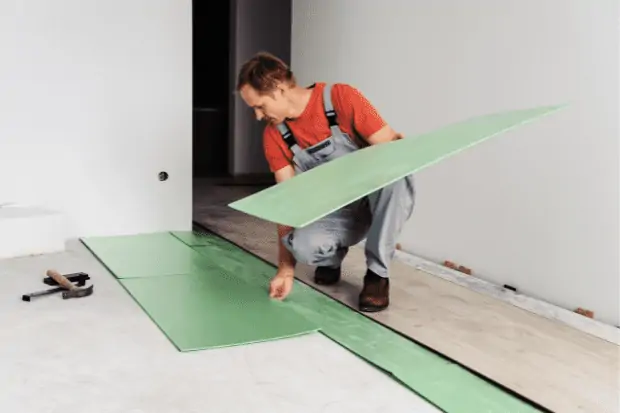
The market is flooded with products that apparently provide world-beating STC and IIC ratings. IIC stands for Impact Insulation Class, and I probably don’t need to explain what this measures.
However, be cautious when looking at these units. For example, FloorMuffler Underlayment claims to have an STC of “up to” 73. This is when it’s used as part of a floating floor setup, which is a lot of work. I discuss how STC and IIC ratings for underlays are calculated and their limitations in a different article.
Instead, pay attention to the material used in the underlayment. Polypropylene foam is a good option, but so is cork. A dense, spongy material is your best bet for floor underlayment.
The underlay that I found provided the best STC and IIC on the market is the FloorMuffler UltraSeal. It’s more than 3 times cheaper than MLV (1lb density). It’s a fairly good sound blocker but not as good as MLV. However, it’s excellent at insulating from impact sounds (ΔIIC: 25).

- Helps attenuate impact and airborne sounds.
- Suitable for hard and soft flooring.
- Useful in apartments and houses.
- STC ratings can be misleading.
2. Acoustic Foam Panels
Acoustic foam is another well-known product that you’ve likely seen before. It’s the stuff used to line recording studios and is often present, to a lesser extent, in restaurants and movie theaters. Unlike other products on this list, you can use acoustic foam tiles on walls and ceilings.
Technically, they’re not for soundproofing but for reducing noise reverberation. So, skip to the next alternative if that’s not you.
Opened-cell foam
Open-cell acoustic foam panels absorb airborne sound waves. They pass into the foam and essentially get trapped, bouncing off all the surfaces within it. As this happens, they lose energy, which is converted into heat.
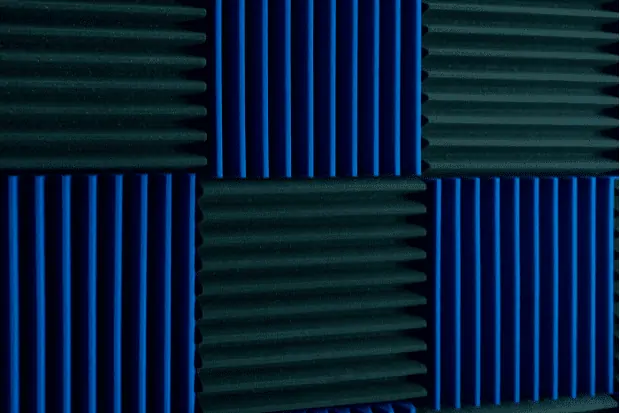
As such, acoustic foam panels don’t necessarily dampen noise or reduce transmission. Instead, it absorbs echo and reverberation, which, in turn, reduces the number of sound waves that can transmit through a surface.
To measure this, we use a rating called Noise Reduction Coefficient (NRC), which ranges from 0 to 1. A rating of 1 means the material absorbs 100% of sound waves. Acoustic foam can have a rating of up to 0.8 or 80% of sound.
- Useful for absorbing echo and reverb.
- Helpful alongside other soundproofing materials.
- Budget-friendly material that’s easy to install.
- Acoustic foam alone won’t soundproof airborne noises
- Ineffective against impact noises.
Closed-cell foam
We should also briefly consider closed-cell foam, such as EVA foam floor tiles. While not a dedicated soundproofing material, its density and elasticity make it a good sound damper. In a pinch, laying these over your floor can reduce impact sounds.

- Reduce impact sounds
- Simple to install
- Very affordable material.
- Almost ineffective at BLOCKING airborne sounds.
3. Green Glue
Green Glue comes in 2 varieties: acoustic caulk and damping compound.
- The acoustic caulk works much like any other sealant, except it has viscoelastic properties (like mass loaded vinyl).
- The damping compound does exactly that, dampen. You spread it on a sheet of drywall during construction, adding another layer of damping to the wall structure. It’s effective only if it’s spread in between two layers of stiff and dense material, like drywall.
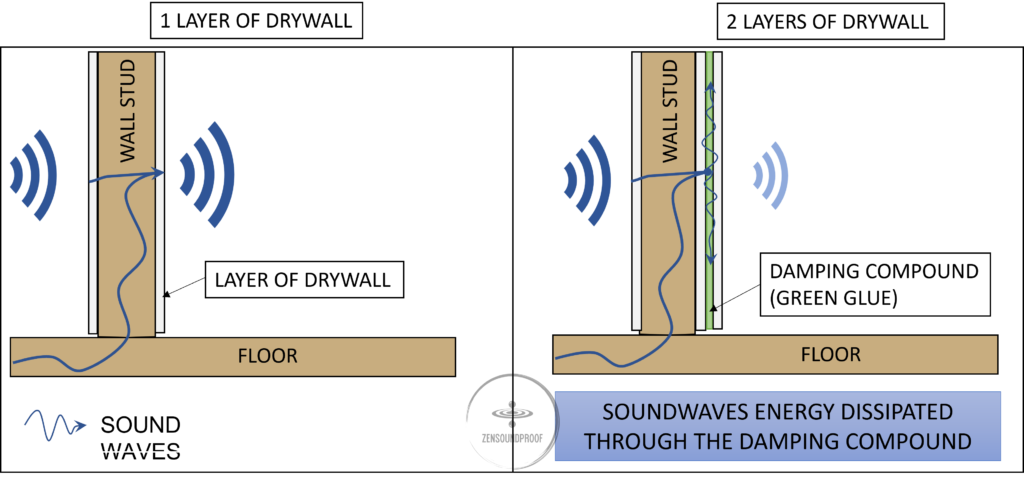
Both the damping compound and acoustic caulk never fully cure, meaning they stay slightly rubbery. This is what helps them reflect and dampen sound waves.
Green Glue has plenty of test data on its website that shows how its products help improve STC ratings. When used with other products, it can increase a wall’s STC rating to 58, which is a big improvement.
But, this is perhaps the biggest drawback of Green Glue. Unlike floor underlayment or MLV, you must use it alongside other products. Granted, you should never really use one product on its own, but at least with MLV you can stick it to a wall and be done. Green Glue supports other products rather than working well on its own.
- Both types are useful for different purposes.
- Easy to work with.
- Has viscoelastic properties similar to MLV.
- Expensive.
- Plays a supporting rather than central role.
4. Wall Insulation
Cavity wall insulation comes in rolls or as blown-in material. While its main purpose is to provide thermal insulation, many of the same principles apply to sound insulation. The air pockets that trap heat also do a good job of absorbing sound waves, much like open-cell foam.
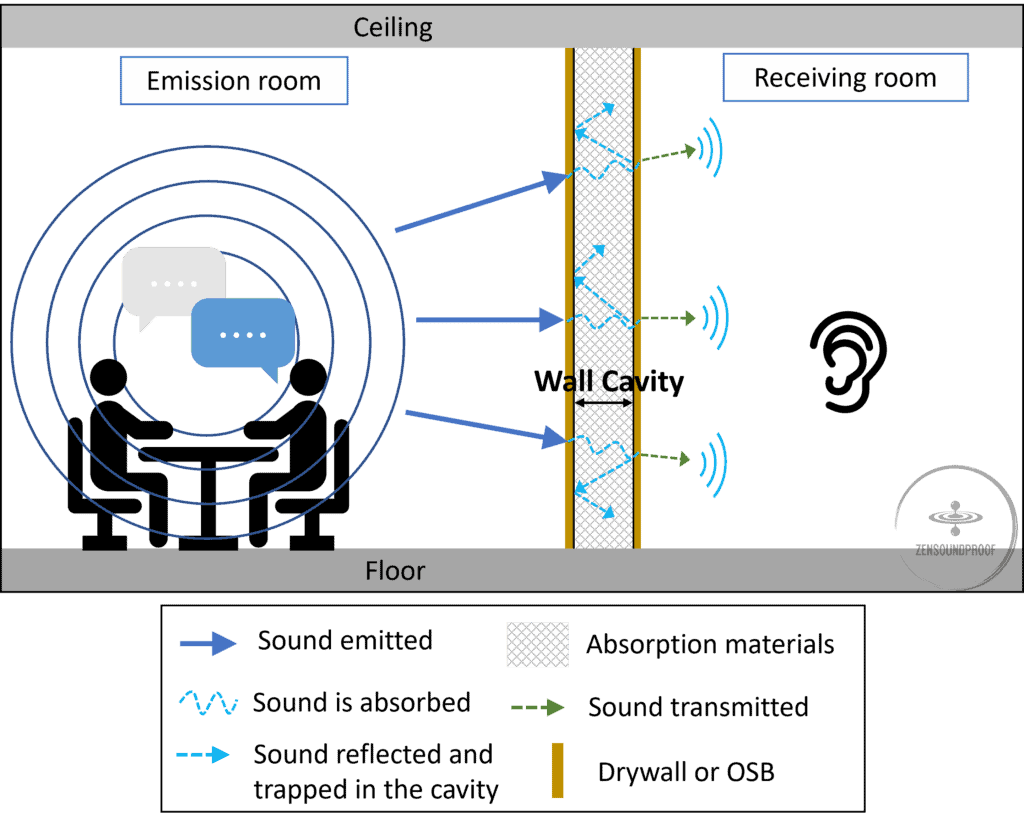
Some kinds, such as mineral wool, are primarily for acoustic insulation. According to Rockwool, its products can add up to 8 STC points to a wall assembly. Fiberglass insulation (both blown-in and rolled) can help with sound absorption, but you typically won’t find an STC rating for the product.
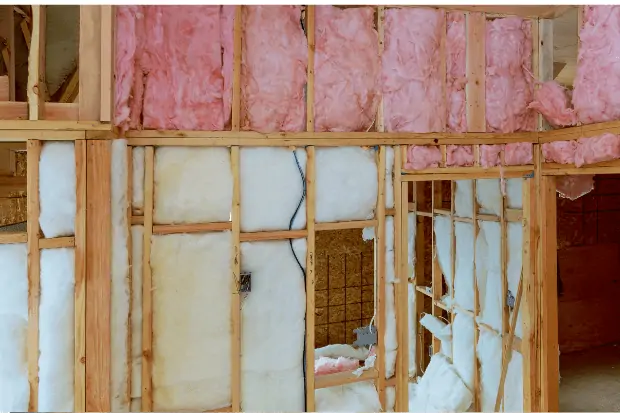
If you plan to use wall insulation to attenuate sound, go with a dedicated acoustic product (like the Rockwool Safe N Sound). More than anything, you’ll have an actual STC rating to work with, so you can get a better idea of which product is best.
But, much like acoustic foam, it doesn’t do a job directly comparable to MLV. That said, it’s a suitable mass loaded vinyl alternative if you’re refitting walls anyway.
- Plenty of options available.
- Can add STC points to a structure with little difficulty.
- Excellent for reducing sound resonances within hollow walls.
- Not all products have an STC rating.
- You need lots of PPE to work with wall insulation.
What Makes a Good Mass Loaded Vinyl Alternative?
Choosing the best mass loaded vinyl alternative depends on several factors. Here are my recommended considerations when picking the right one.
Room
First, know which part of the room you’re working with. As you might have gathered, some products are more suitable than others for different areas.
For example, you wouldn’t use floor underlayment to line walls because it works for the wrong kind of noise.
I’ve mentioned where each product is most useful unless it’s obvious.
Type of Noise
Next, know which type of noise you’re trying to block. Generally, impact noise will relate to floors; everything else will be airborne noise (unless your neighbors regularly hammer things into walls).
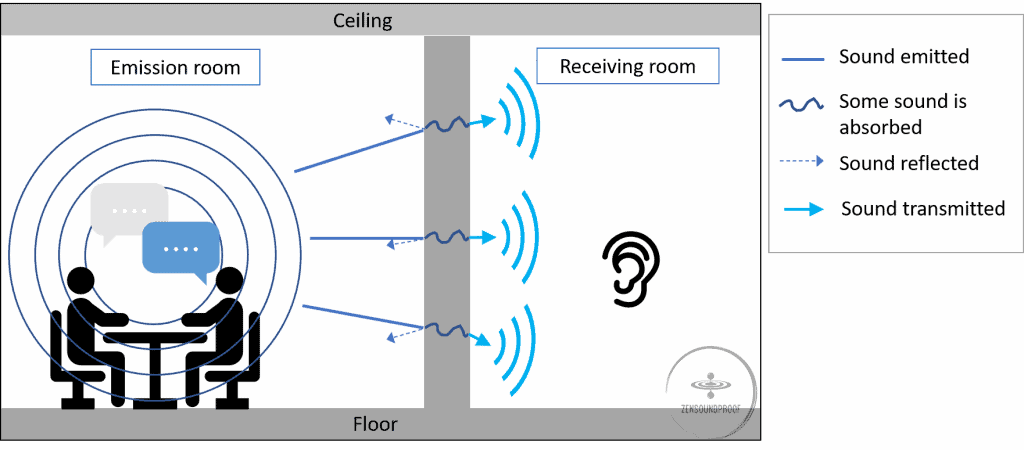
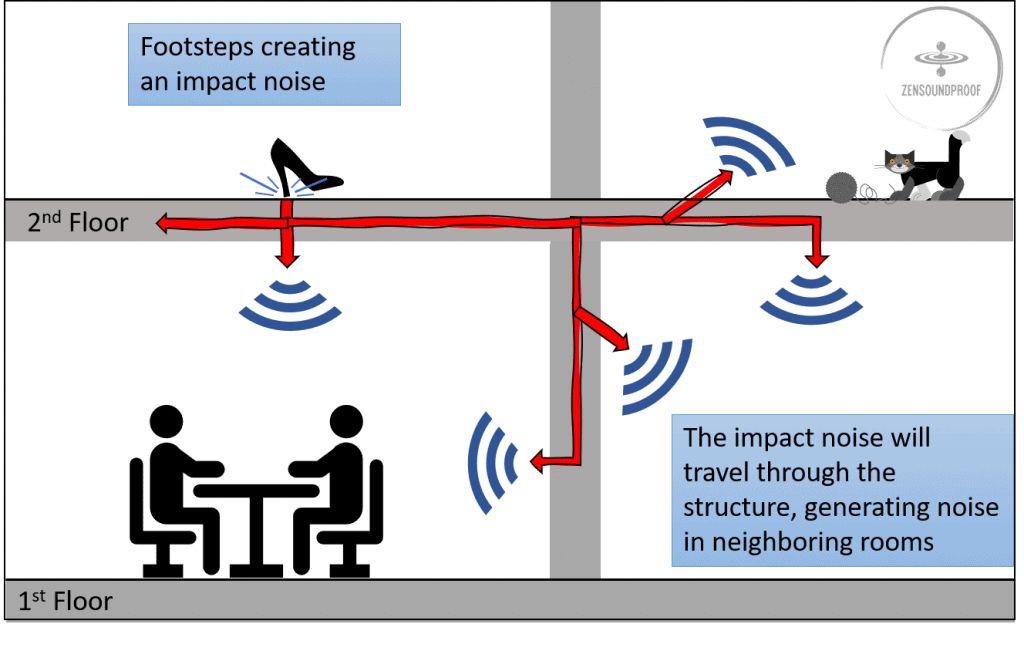
As such, most mass loaded vinyl alternatives will help to reduce airborne sounds. If you want more specific information on reducing impact sounds, check out my article on how to soundproof a floor.
Budget
Considering MLV is a pricey product, it makes sense that a mass loaded vinyl alternative should be cheaper. For all but Green Glue, this is generally true. But, at nearly $400 for 5 gallons, it takes the prize for the most expensive alternative.
Check out my comparison study between Green Glue and MLV. There, I review STC improvement per dollar spent.
If you want dedicated soundproofing products, you can expect to pay a bit more. It’s because soundproofing is a fairly closed market, meaning companies can charge what they like for “specialist” products.
However, if you’re on a really tight budget, I recommend checking out my articles on cheap ways to reduce echo and cheap ways to soundproof a ceiling. While they won’t cost as much, they should provide satisfactory results.
Final Thoughts
I hope this article has helped you narrow down your choices for the best mass loaded vinyl alternative for your needs.
I don’t have a top-rated product, as it entirely depends on which part of the room you’re working with. That said, most types of cavity insulation are good all-rounders.
Do you have any other good MLV alternatives that I’ve missed off the list? Let m know in the comments below.



2 thoughts on “Top 4 Mass Loaded Vinyl Alternative: Best Options for Your Needs”
What would you suggest using if you live by the road and would like to make your yard a bit more quite?
I would prefer a more economic option to MLV as it would take to much $$$ to cover 6ft+ fence
Hi there,
Unfortunately, MLV is one of the cheapest dedicated soundproofing materials for your yard fencing.
Otherwise, you’d have to buy dedicated soundproof blankets which will be more expensive in $/surface covered.
Whatever material you pick for your fence, try to consider the heaviest one.